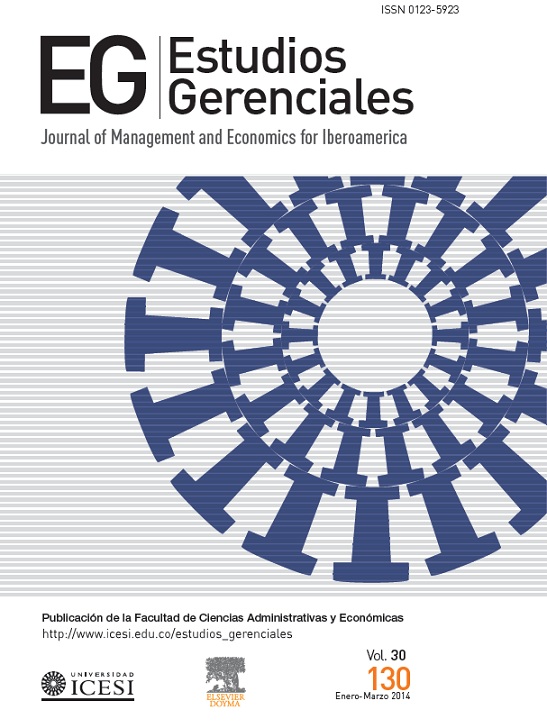El uso de los arquetipos en la industria de la moda en Colombia
DOI:
https://doi.org/10.1016/j.estger.2014.01.012Palabras clave:
Marca, Identidad de marca, Personalidad de marca, Arquetipos, ModaResumen
Los arquetipos se han presentado como una herramienta poderosa para la definición de la personalidadde marca y son especialmente útiles en el mercadeo de marcas de moda. El presente estudio busca
comprender el uso de los arquetipos en empresas colombianas de moda, presenta la percepción que tienen
los empresarios de esta herramienta e identifica las motivaciones y los obstáculos para su incorporación.
Se realizaron 16 entrevistas a profundidad, la mayoría con empresarios que estaban implementando o
deseaban implementar los arquetipos. Se evidencia que los jefes de las marcas de moda colombianas
presentan varias motivaciones para usar la herramienta; sin embargo, el uso de arquetipos es limitado y
presenta múltiples obstáculos para su implementación.
Descargas
Referencias
Aaker, D. (1996). El éxito de tu producto está en la marca (1.a ed.). México D.F.: Prentice Hall Hispanoamérica.
Aaker, J. L. (1997). Dimensions of brand personality. Journal of Marketing, 34(3), 347–356.
Benavides, M. O. y Gómez-Restrepo, C. (2005). Métodos en investigación cualitativa: triangulación. Revista Colombiana de Psiquiatría, 34(1), 118–124.
Bhargava, R. (2009). Personalidad de marca. México D.F: McGraw Hill.
Brown, S., Kozinets, R. V. y Sherry, J. F., Jr. (2003). Teaching old brands new tricks: Retro branding and the revival of brand meaning. Journal of Marketing, 67, 19–33.
Cisterna, F. C. (2005). Categorización y triangulación como procesos de validación del conocimiento en investigación cualitativa. Theoria, 14(1), 61–71.
Escobar, S. (1998). La equidad de marca ''brand equity'', una estrategia para crear y agregar valor. Estudios Gerenciales, 1, 35–41.
Fernández, S. E. y Delgado, B. M. (2011). Marcas de experiencia: marcando la diferencia. Estudios Gerenciales, 27(121), 59–78.
Gallo, G. (2000). Posicionamiento: el caso latinoamericano. Bogotá: McGraw Hill Interamericana.
Gröppel-Klein, A., Domke, A. y Bartmann, B. (2006). Pretty woman or Erin Brockovich? Unconscious and conscious reactions to commercials and movies shaped by fairy tale archetypes-results from two experimental studies. Advances in Consumer Research, 33, 163–174.
Gupta, S., Grant, S. y Melewar, T. C. (2008). The expanding role of intangible assets of the brand. Management Decision, 46(6), 948–960.
Hirschman, E. C. (2000). Consumers' use of intertextuality and archetypes. Advances in Consumer Research, 27, 57–63.
Jung, C. G. (1938). Psychology and religion. New York: New Haven and London. Jung, C. G. (1970). Arquetipos e inconsciente colectivo. Madrid: Paidós Ibérica.
Kniazeva, M. y Belk, R. W. (2007). Packaging as a vehicle for mythologizing the brand. Consumption, Markets and Culture, 10(1), 51–69.
Kozinets, R. V. (2001). Utopian enterprise: Articulating the meanings of star trek's culture of consumption. Journal of Consumer Research, 28, 67–88.
Lamb, C. W., Hair, J. F. y McDaniel, C. (1998). Marketing. México D.F: International Thomson.
Maloney, A. (1999). Preference ratings of images representing archetypal themes: An empirical study of the concept of archetypes. Journal of Analytical Psychology, 44, 101–116.
Mark, M. y Pearson, C. S. (2001). The hero and the outlaw: Building extraordinary brands through the power of archetypes. New York: McGraw-Hill.
Maso-Fleischman, R. (1997). Archetype research for advertising: A Spanish-language example. Journal of Advertising Research, 37(5), 81–84.
Ministerio de Comercio, Industria y Turismo de Colombia (2008). En 2009, ocho sectores liderarán el Programa de Transformación Productiva [consultado 25 Mar 2009]. Disponible en: http://www.mincomercio.gov.co/eContent/NewsDetail.asp?ID=6816&IDCompany=1.
Morris, L. y Schmolze, R. (2006). Consumer archetypes: A new approach to developing consumer understanding frameworks. Journal of Advertising Research, 4(3), 289–300.
Murtagh, J. (1998). The power of archetypes, innocent, explorer and sage. Journal of Analytical Psychology, 43, 325–343.
Patton, M. Q. (2002). Qualitative Research & Evaluation Methods (12.a ed.). Thousand Oaks: Sage Publications.
Randazzo, S. (2006). Subaru the emotional myths behind the brand' growth. Journal of Advertising Research, 46(1), 11–17.
Ries, A. y Ries, L. (2000). 22 Leyes inmutables de la marca. Madrid: McGraw Hill.
Revista Dinero (2011). Sectores de talla mundial, lideran el crecimiento [consultado 15 Jun 2012]. Disponible en: http://www.dinero.com/negocios/articulo/sectores-talla-mundial-base-del-crecimiento/136077.
Shu-pei, T. (2006). Investigating archetype-icon transformation in brand marketing. Marketing Intelligence & Planning, 24(6), 648–663.
Revista Marketing (2009). The Jungian Approach. Marzo [consultado 1 Dic 2011]. Disponible en: http://www.marketingmagazine.co.uk/.
Veen, S. V. (1994). The consumption of heroes and the hero hierarchy of effects. Advances in Consumer Research, 21, 332–336.
Vera, J. (2008). Perfil de valor de marca y la medición de sus componentes. Academia. Revista Latinoamericana de Administración, 41, 69–89.
Wathieu, L., Liu, Y. y Zaltman, G. (2004). Rooting marketing strategy in human universals. GLOBE Management Review, 1(1), 8–15.
Wong, H. Y. y Merrilees, B. (2005). A brand orientation typology for SMEs: A case research approach. Journal of Product & Brand Management, 14(3), 155–162.
Woodside, A. G., Sood, S. y Miller, K. E. (2008). When consumers and brands talk: Storytelling theory and research in psychology and marketing. Psychology & Marketing, 25(2), 97–145.
Publicado
Número
Sección
Licencia
Los autores de artículos serán responsables de los mismos, y por tal no comprometen los principios o políticas de la Universidad Icesi ni las del Comité Editorial de la revista Estudios Gerenciales. Los autores autorizan y aceptan la cesión de todos los derechos a la revista Estudios Gerenciales, tanto en su publicación impresa como electrónica. Luego de publicado el artículo, puede ser reproducido sin autorización, mencionando autor(es), título, año, volumen, número y rango de páginas de la publicación, y como fuente: Estudios Gerenciales (abstenerse de usar Revista Estudios Gerenciales).








